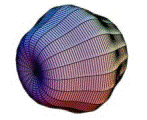Department of Physics and Astronomy: Publications and Other Research

Timothy J. Gay Publications
Document Type
Article
Date of this Version
2018
Citation
J. Phys. B: At. Mol. Opt. Phys. 51 (2018) 21LT01 (6pp)
doi:10.1088/1361-6455/aae1bd
Abstract
We have measured electron-circularly-dichroic asymmetries when longitudinally-polarized (chiral) electrons are scattered quasi-elastically by chiral halocamphor molecules: 3-bromocamphor (C10H15BrO), 3-iodocamphor (C10H15IO), and 10-iodocamphor. The proposed dynamic origins of these asymmetries are considered in terms of three classical models related to Mott scattering, target electron helicity density, and spin-other-orbit interactions. The asymmetries observed for 3-bromocamphor and 3-iodocamphor scale roughly as Z2, where Z is the nuclear charge of the heaviest atom in the target molecule, but the scaling is violated by 10- iodocamphor, which has a smaller asymmetry than that for 3-iodocamphor. This is in contrast to the asymmetries in the collision channel associated with dissociative electron attachment, in which 10-iodocamphor has a much larger asymmetry. All of the available electron-circularlydichroic data taken to date are considered in an effort to systematically address the dynamical cause of the observed chiral asymmetries.


Comments
Original content from this work may be used under the terms of the Creative Commons Attribution 3.0 licence.